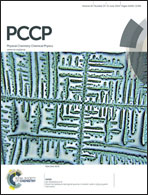Warm white light generation from a single phase Dy3+ doped Mg2Al4Si5O18 phosphor for white UV-LEDs†
Abstract
A series of Mg2−xAl4Si5O18:xDy3+ (0 ≤ x ≤ 0.18) samples were synthesized, for the first time, by a solid state method both in a reducing atmosphere and in air. XRD, diffuse reflectance spectra, excitation spectra, emission spectra, decay times and thermal quenching were used to investigate the structure, photoluminescence, energy transfer and thermal properties. The results show that Mg2Al4Si5O18:Dy3+ can efficiently absorb UV light and emit violet-blue light in the range of 400 to 500 nm from oxygen vacancies in the host as well as blue light (∼480 nm) and yellow light (∼576 nm) from the f–f transitions of Dy3+. The emission intensities of the samples obtained under a reducing atmosphere are far superior to those of the samples obtained in air due to an efficient energy transition from oxygen vacancies in the host to Dy3+. An analysis of the thermal quenching shows that the phosphor Mg2Al4Si5O18:Dy3+ has excellent thermal properties. The emission intensities of typical samples synthesized in a reducing atmosphere and in air at 250 °C are 70% and 81% of their initial intensities at 20 °C, respectively. In addition, the emission colors of all of the samples are located in the white light region and the optimal chromaticity coordinates and Correlated Color Temperature are (x = 0.34, y = 0.33) and 5129 K, respectively. Therefore, these white Mg2Al4Si5O18:Dy3+ phosphors could serve as promising candidates for white-light UV-LEDs.


 Please wait while we load your content...
Please wait while we load your content...